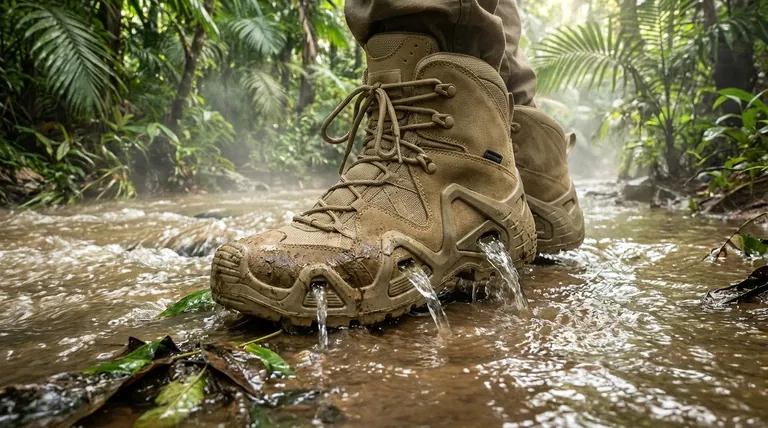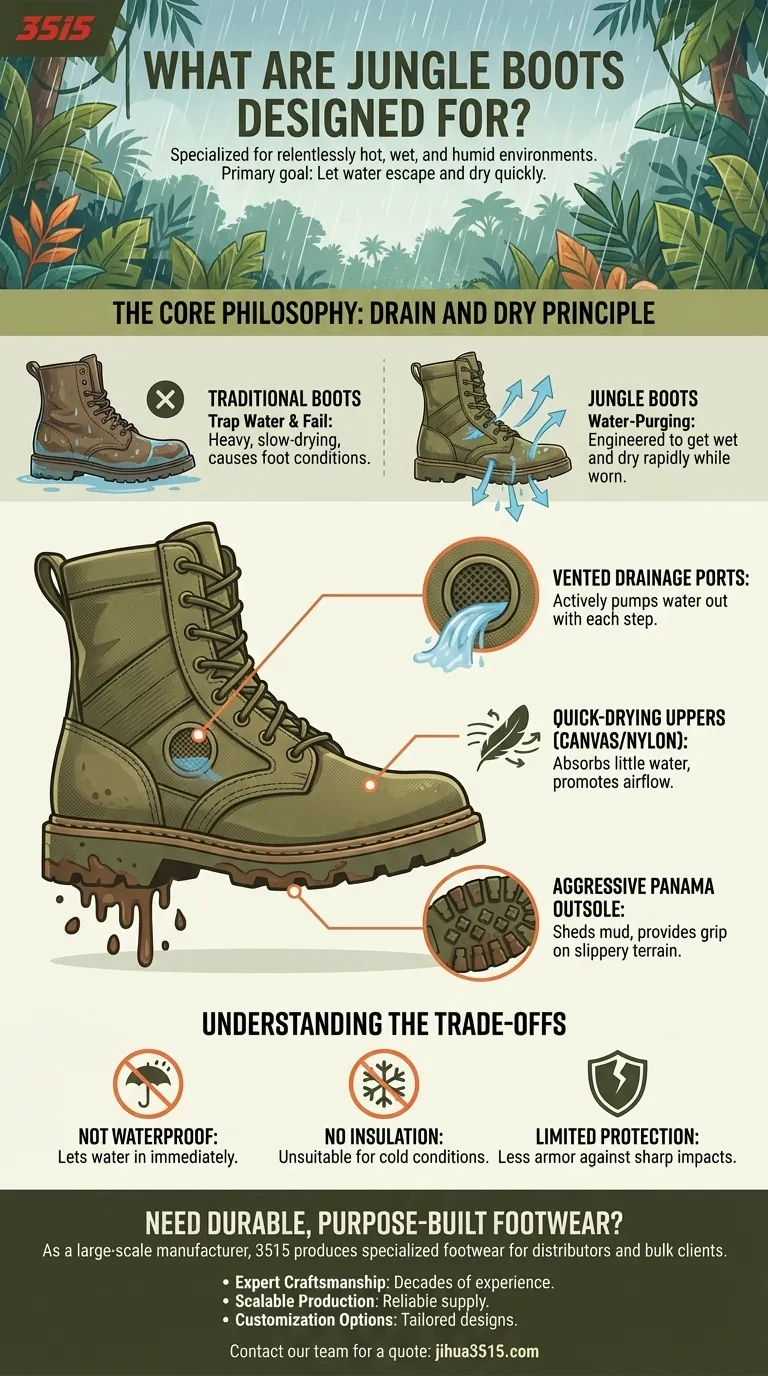At their core, jungle boots are a specialized tool designed for one purpose: to keep a soldier's or adventurer's feet functional in relentlessly hot, wet, and humid environments. Unlike standard boots that prioritize keeping water out, jungle boots are built on the principle that feet will get wet, so the primary goal is to let water escape and dry out as quickly as possible. Their design combines lightweight, quick-drying materials with dedicated drainage features.
The fundamental design philosophy of a jungle boot is not to be waterproof, but to be "water-purging." It accepts the reality of a wet environment and is engineered to drain water and promote airflow, mitigating the risk of debilitating foot conditions that plague users of traditional leather boots in the tropics.

The Core Design Philosophy: Why Standard Boots Fail
Traditional combat or hiking boots, especially those made of thick leather or with waterproof membranes, become a liability in a true jungle environment. Understanding why they fail is key to appreciating the jungle boot's specific engineering.
The Problem with Waterproofing
In environments with constant rain, river crossings, or extreme humidity, even the best waterproof boots eventually get wet. Water can come over the top of the boot or sweat can accumulate inside with nowhere to go.
Once wet, a traditional leather or waterproof boot becomes extremely heavy. Worse, it can take days to dry, creating a perfect breeding ground for bacteria and fungus, leading to conditions like trench foot.
The "Drain and Dry" Principle
Jungle boots operate on a completely different principle. They are designed to get wet and, more importantly, to dry out rapidly while still being worn.
This approach prioritizes ventilation and water expulsion above all else. The goal is to keep the foot as dry as possible by constantly removing moisture, rather than trying to create an impenetrable (and ultimately failed) barrier against it.
Key Features and Their Purpose
Every primary feature of a jungle boot directly serves its "drain and dry" philosophy. These are not arbitrary design choices; they are solutions born from harsh experience in tropical warfare.
Vented Drainage Ports
This is the most iconic feature. Jungle boots have small, screened holes (often metal grommets) located on the inner arch of the boot.
Their sole purpose is to act as one-way drains. When you step, the pressure forces water out through the vents, actively pumping the boot dry with every movement.
Quick-Drying Uppers
The upper portion of a classic jungle boot is typically made from canvas or nylon fabric, not full-grain leather.
These materials absorb very little water and dry exceptionally fast when exposed to air. This works in concert with the drainage ports to ensure the boot doesn't stay waterlogged and heavy. The lower portions, around the foot itself, are often still leather for durability and protection.
Aggressive Outsoles
The sole of a jungle boot features a deep, aggressive tread pattern, often called a Panama sole.
This design is engineered to shed mud and clay quickly, providing a secure grip on slippery, unstable terrain like jungle floors and muddy slopes.
Understanding the Trade-offs
The specialized nature of jungle boots means they come with significant trade-offs. Choosing them for the wrong environment can be a serious mistake.
They Are Not Waterproof
This cannot be overstated. By design, jungle boots will let water in immediately. Stepping in a puddle or creek will result in an instantly wet foot. Their function is to get that water out just as quickly.
They Offer Minimal Insulation
The same features that make them brilliant for hot weather—ventilation and lightweight materials—make them entirely unsuitable for cold conditions. They provide almost no insulation and will lead to dangerously cold feet in low temperatures.
Protection Can Be Limited
Compared to a modern, heavy-duty hiking or combat boot, the canvas or nylon uppers offer less protection against sharp rocks or impacts. They prioritize breathability and low weight over maximum armor.
Making the Right Choice for Your Environment
To select the right footwear, you must match the tool to the specific environmental challenge you face.
- If your primary focus is hot, wet, and humid conditions: The jungle boot is the superior choice, as it is purpose-built to drain water and keep your feet healthy.
- If your primary focus is dry or mixed-weather hiking: A modern hiking boot, perhaps with a breathable waterproof membrane like Gore-Tex, will offer better all-around support and protection.
- If your primary focus is cold or freezing weather: Avoid jungle boots entirely and select an insulated, waterproof boot designed specifically for cold temperatures.
Ultimately, understanding a jungle boot's core purpose—to purge water rather than block it—empowers you to make the correct decision for your specific mission.
Summary Table:
| Feature | Purpose | Benefit |
|---|---|---|
| Vented Drainage Ports | Actively expel water with each step | Prevents waterlogging, reduces weight |
| Quick-Drying Uppers (Canvas/Nylon) | Minimizes water absorption, promotes airflow | Fast drying, reduces risk of trench foot |
| Aggressive Panama Outsoles | Sheds mud and provides grip on slippery terrain | Enhanced stability and safety in mud |
| Lightweight Construction | Reduces fatigue during long treks | Increases mobility and endurance |
Need Durable, Purpose-Built Footwear for Your Operations?
As a large-scale manufacturer, 3515 produces a comprehensive range of specialized footwear for distributors, brand owners, and bulk clients. Our production capabilities encompass all types of boots, including high-performance jungle boots designed for the most demanding environments.
Partner with us to get:
- Expert Craftsmanship: Decades of experience in manufacturing durable, functional footwear.
- Scalable Production: Reliable supply to meet the demands of distributors and large orders.
- Customization Options: Tailor designs to meet your specific brand or operational needs.
Let's discuss how we can equip your team or product line with the right footwear.
Contact our team today for a quote
Visual Guide

Related Products
- Wholesale Waterproof Tactical Boots Custom Suede & High-Traction Soles
- Factory Direct Wholesale Rain Boots Durable Waterproof & Fully Customizable
- Premium Wholesale Waterproof Safety Boots High Performance Protection for Industrial Markets
- Wholesale High-Traction Camo Boots - Custom Manufacturer for Brands
- High Performance Fire-Retardant Waterproof Safety Boots
People Also Ask
- How do uniform requirements influence the choice between tactical boots and sneakers? Select Compliant Footwear for Your Role
- Are military camouflage boots waterproof? How to Choose Boots That Keep Feet Dry
- What waterproof technology is used in tactical boots? Unlock All-Weather Performance & Protection
- Why is waterproofing important for tactical boots? Protect Your Feet and Gear in Any Mission
- Why is waterproofing important in tactical boots? Essential for Foot Health & Mission Success



















